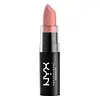What's inside
What's inside
 Key Ingredients
Key Ingredients

 Benefits
Benefits

 Concerns
Concerns

 Ingredients Side-by-side
Ingredients Side-by-side

Butter
Skin ConditioningBis-Diglyceryl Polyacyladipate-2
EmollientEthylhexyl Palmitate
EmollientIsopropyl Palmitate
EmollientOctyldodecanol
EmollientOleyl Alcohol
EmollientEuphorbia Cerifera Wax
Beeswax
Emulsion StabilisingHydrogenated Microcrystalline Wax
Emulsion StabilisingIsostearyl Isostearate
EmollientPolyisobutene
Ozokerite
Emulsion StabilisingPolyethylene
AbrasiveCopernicia Cerifera Wax
Tocopheryl Acetate
AntioxidantTocopherol
AntioxidantHydrogenated Palm Glycerides Citrate
EmollientAlumina
AbrasiveBHT
AntioxidantParfum
MaskingButter, Bis-Diglyceryl Polyacyladipate-2, Ethylhexyl Palmitate, Isopropyl Palmitate, Octyldodecanol, Oleyl Alcohol, Euphorbia Cerifera Wax, Beeswax, Hydrogenated Microcrystalline Wax, Isostearyl Isostearate, Polyisobutene, Ozokerite, Polyethylene, Copernicia Cerifera Wax, Tocopheryl Acetate, Tocopherol, Hydrogenated Palm Glycerides Citrate, Alumina, BHT, Parfum
Polybutene
Diisostearyl Malate
EmollientHydrogenated Polyisobutene
EmollientDiphenylsiloxy Phenyl Trimethicone
Skin ConditioningBis-Diglyceryl Polyacyladipate-2
EmollientOctyldodecyl Neopentanoate
EmollientHydrogenated Polydecene
EmollientDiisopropyl Dimer Dilinoleate
EmollientC10-30 Cholesterol/Lanosterol Esters
EmulsifyingOzokerite
Emulsion StabilisingPolyethylene
AbrasiveSynthetic Wax
AbrasiveSilica Silylate
EmollientMica
Cosmetic ColorantAloe Barbadensis Leaf Extract
EmollientSodium Hyaluronate
HumectantQuartz
AbrasiveBHT
AntioxidantButylene Glycol
HumectantCaprylyl Glycol
EmollientEthylhexyl Palmitate
EmollientHexylene Glycol
EmulsifyingPentaerythrityl Tetraethylhexanoate
EmollientSilica Dimethyl Silylate
EmollientParfum
MaskingPhenoxyethanol
PreservativePolybutene, Diisostearyl Malate, Hydrogenated Polyisobutene, Diphenylsiloxy Phenyl Trimethicone, Bis-Diglyceryl Polyacyladipate-2, Octyldodecyl Neopentanoate, Hydrogenated Polydecene, Diisopropyl Dimer Dilinoleate, C10-30 Cholesterol/Lanosterol Esters, Ozokerite, Polyethylene, Synthetic Wax, Silica Silylate, Mica, Aloe Barbadensis Leaf Extract, Sodium Hyaluronate, Quartz, BHT, Butylene Glycol, Caprylyl Glycol, Ethylhexyl Palmitate, Hexylene Glycol, Pentaerythrityl Tetraethylhexanoate, Silica Dimethyl Silylate, Parfum, Phenoxyethanol
Ingredients Explained
These ingredients are found in both products.
Ingredients higher up in an ingredient list are typically present in a larger amount.
BHT is a synthetic antioxidant and preservative.
As an antioxidant, it helps your body fight off free-radicals. Free-radicals are molecules that may damage your skin cells.
As a preservative, it is used to stabilize products and prevent them from degrading. Specifically, BHT prevents degradation from oxidation.
The concerns related to BHT come from oral studies; this ingredient is currently allowed for use by both the FDA and EU.
However, it was recently restricted for use in the UK as of April 2024.
Learn more about BHTThis ingredient is lipid-based synthetic skin-conditioning agent derived from adipic acid and a mixture of fatty acids. It is often called a lanolin substitute.
As an emollient, it helps soften and hydrate the skin. Emollients create a barrier on the skin to trap moisture in.
Due to its fatty acid base, it may not be Malassezia folliculitis safe.
Learn more about Bis-Diglyceryl Polyacyladipate-2Ethylhexyl Palmitate, also known as octyl palmitate, is created from 2-ethylhexyl alcohol and palmitic acid. It is a fatty acid ester.
The fatty acid content of Ethylhexyl Palmitate makes it an emollient. Emollients help soften and hydrate your skin by trapping moisture within.
Ethylhexyl Palmitate is also used to help improve the texture of cosmetics. It helps other ingredient dissolve in products and help disperse ingredients more evenly.
You'll likely find this ingredient in sunscreen, as it is often used to mix UV-blocking ingredients such as avobenzone and ethylhexyl triazone.
It can also help stabilize the fragrances in a product as a fragrance fixative.
Ethylhexyl Palmitate can be used to substitute mineral oil.
Due to its high fatty acid content, it may not be fungal-acne safe.
Learn more about Ethylhexyl PalmitateOzokerite is a naturally occuring mineral wax. In cosmetics, ozokerite is used as a texture enhancer.
Ceresin wax is derived from this ingredient.
The melting point of ozokerite is 58-100 C.
Ozokerite is found all over the world including Scotland, the US, and India.
Learn more about OzokeriteParfum is a catch-all term for an ingredient or more that is used to give a scent to products.
Also called "fragrance", this ingredient can be a blend of hundreds of chemicals or plant oils. This means every product with "fragrance" or "parfum" in the ingredients list is a different mixture.
For instance, Habanolide is a proprietary trade name for a specific aroma chemical. When used as a fragrance ingredient in cosmetics, most aroma chemicals fall under the broad labeling category of “FRAGRANCE” or “PARFUM” according to EU and US regulations.
The term 'parfum' or 'fragrance' is not regulated in many countries. In many cases, it is up to the brand to define this term.
For instance, many brands choose to label themselves as "fragrance-free" because they are not using synthetic fragrances. However, their products may still contain ingredients such as essential oils that are considered a fragrance by INCI standards.
One example is Calendula flower extract. Calendula is an essential oil that still imparts a scent or 'fragrance'.
Depending on the blend, the ingredients in the mixture can cause allergies and sensitivities on the skin. Some ingredients that are known EU allergens include linalool and citronellol.
Parfum can also be used to mask or cover an unpleasant scent.
The bottom line is: not all fragrances/parfum/ingredients are created equally. If you are worried about fragrances, we recommend taking a closer look at an ingredient. And of course, we always recommend speaking with a professional.
Learn more about ParfumPolyethylene is a synthetic ingredient that helps the skin retain moisture. It is a polymer.
It is also typically used within product formulations to help bind solid ingredients together and thicken oil-based ingredients. When added to balms and emulsions, it helps increase the melting point temperature.